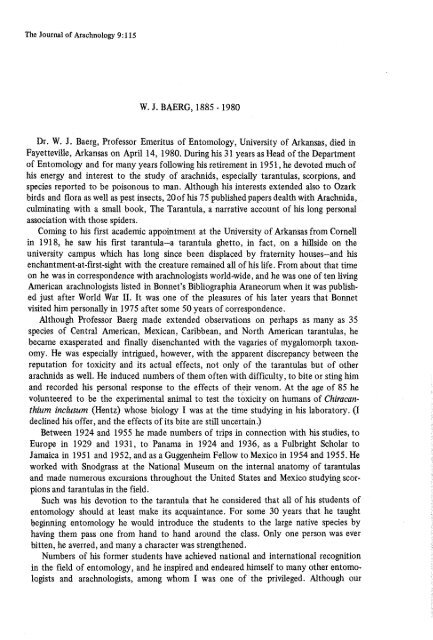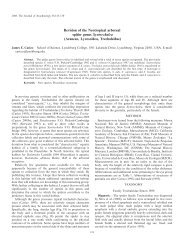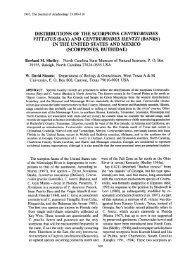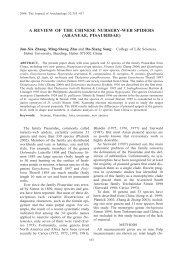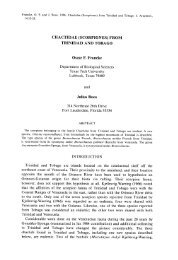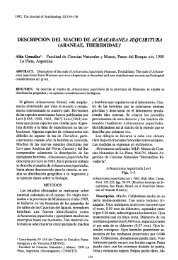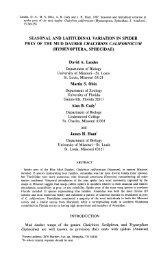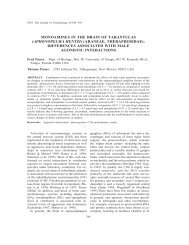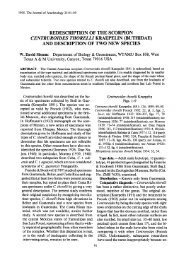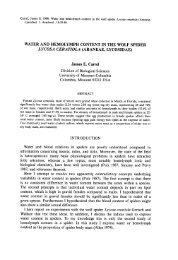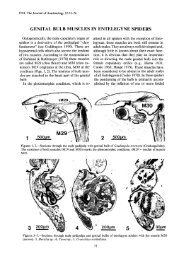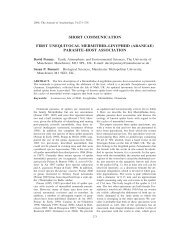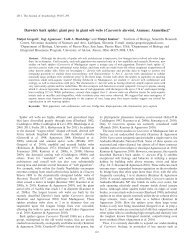WJ BAERG, 1885 - American Arachnological Society
WJ BAERG, 1885 - American Arachnological Society
WJ BAERG, 1885 - American Arachnological Society
Create successful ePaper yourself
Turn your PDF publications into a flip-book with our unique Google optimized e-Paper software.
The Journal of Arachnology 9 :115<br />
W. J. <strong>BAERG</strong>, <strong>1885</strong> - 198 0<br />
Dr. W. J . Baerg, Professor Emeritus of Entomology, University of Arkansas, died i n<br />
Fayetteville, Arkansas on April 14, 1980 . During his 31 years as Head of the Department<br />
of Entomology and for many years following his retirement in 1951, he devoted much o f<br />
his energy and interest to the study of arachnids, especially tarantulas, scorpions, and<br />
species reported to be poisonous to man . Although his interests extended also to Ozark<br />
birds and flora as well as pest insects, 20of his 75 published papers dealth with Arachnida ,<br />
culminating with a small book, The Tarantula, a narrative account of his long persona l<br />
association with those spiders .<br />
Coming to his first academic appointment at the University of Arkansas from Cornel<br />
in 1918, he saw his first tarantula—a tarantula ghetto, in fact, on a hillside on th e<br />
university campus which has long since been displaced by fraternity houses—and hi s<br />
enchantment-at-first-sight with the creature remained all of his life . From about that time<br />
on he was in correspondence with arachnologists world-wide, and he was one of ten living<br />
<strong>American</strong> arachnologists listed in Bonnet's Bibliographia Araneorum when it was published<br />
just after World War II. It was one of the pleasures of his later years that Bonne t<br />
visited him personally in 1975 after some 50 years of correspondence .<br />
Although Professor Baerg made extended observations on perhaps as many as 3 5<br />
species of Central <strong>American</strong>, Mexican, Caribbean, and North <strong>American</strong> tarantulas, h e<br />
became exasperated and finally disenchanted with the vagaries of mygalomorph taxonomy.<br />
He was especially intrigued, however, with the apparent discrepancy between th e<br />
reputation for toxicity and its actual effects, not only of the tarantulas but of othe r<br />
arachnids as well . He induced numbers of them often with difficulty, to bite or sting hi m<br />
and recorded his personal response to the effects of their venom. At the age of 85 he<br />
volunteered to be the experimental animal to test the toxicity on humans of Chiracanthium<br />
inclusum (Hentz) whose biology I was at the time studying in his laboratory . (I<br />
declined his offer, and the effects of its bite are still uncertain .)<br />
Between 1924 and 1955 he made numbers of trips in connection with his studies, to<br />
Europe in 1929 and 1931, to Panama in 1924 and 1936, as a Fulbright Scholar t o<br />
Jamaica in 1951 and 1952, and as a Guggenheim Fellow to Mexico in 1954 and 1955 . He<br />
worked with Snodgrass at the National Museum on the internal anatomy of tarantula s<br />
and made numerous excursions throughout the United States and Mexico studying scorpions<br />
and tarantulas in the field .<br />
Such was his devotion to the tarantula that he considered that all of his students o f<br />
entomology should at least make its acquaintance . For some 30 years that he taught<br />
beginning entomology he would introduce the students to the large native species b y<br />
having them pass one from hand to hand around the class . Only one person was ever<br />
bitten, he averred, and many a character was strengthened .<br />
Numbers of his former students have achieved national and international recognition<br />
in the field of entomology, and he inspired and endeared himself to many other entomologists<br />
and arachnologists, among whom I was one of the privileged . Although our
The Journal of Arachnology 9 :11 6<br />
connections were intermittent, they spanned some 45 years . I first came under his influence<br />
as a high school student when he took me on a personally guided tour of his<br />
"tarantula hill" south of Fayetteville . He had at one time the burrows of as many as 8 0<br />
Dugesiella hentzi marked in this locale, and he recorded their habits and life history dat a<br />
as the colony waxed and waned. About 25 years later he obligingly offered to share his<br />
laboratory with me and for nearly three years provided a daily fare of wit and wisdom .<br />
In the 1930 's he built a house on a spacious lot on the outskirts of Fayetteville upon<br />
which he collected and planted many of the lesser common species of Ozark trees an d<br />
plants. He also transplanted some of the native tarantulas there for easily accessibl e<br />
observation . To avoid the disturbance of wandering dogs and children he surrounded th e<br />
entire property with a four-foot high stone wall, one of the iron gate entrances of whic h<br />
was wrought in the form of an orb web with its spider in place . He outlived some of the<br />
trees he planted and all of his tarantulas, but the garden still retains its character an d<br />
beauty. Such a long career as his may be essential to study the life history of suc h<br />
long-lived creatures. His is probably the only complete life history study of Dugesiella<br />
hentzi one which lasted 24 years from eclosion to death in the specimens he cultured .<br />
The considerable arachnological library that Professor Baerg had accumulated throug h<br />
his more than 60 years of work, containing many now-rare reprints, has been donated t o<br />
the University of Arkansas Library where they are now bound and have become a part o f<br />
that library 's rare book collection .<br />
LIST OF ARACHNOLOGICAL PUBLICATIONS - W . J . <strong>BAERG</strong><br />
William B . Peck<br />
1922 . Regarding the habits of tarantulas and the effects of their poison . Sci. Monthly, 14(5) :482-489.<br />
1923 . The black widow: Its life history and the effects of the poison . Sci. Monthly, 18(6) :535-547 .<br />
1923 . The effects of the bite of Latrodectus mactans (Fabr .) .J . Parasit ., 9 :161-169 .<br />
1925 . The effect of the venom of some supposedly poisonous arthropods of the Canal Zone . Ann .<br />
Entomol. Soc. Amer ., 18:471-478 .<br />
1926. Regeneration of appendages in the tarantula Eurypelma californica Ausserer. Ann . Entomol .<br />
Soc . Amer., 19(4) :512-513 .<br />
1928 . Some studies of a trapdoor spider (Araneae : Aviculariidae). Entomol. News, 39(1) :1-4 .<br />
1928. The life cycle and mating habits of the male tarantula . Quart. Rev . Biol. 3(1) :109-116 .<br />
1929. Some poisonous arthropods of North and Central America . Trans . IV Internatl . Congr . Entomol<br />
., 2 :418-438 .<br />
1929 . Cocoon making by the tarantula. Ann. Entomol . Soc . Amer ., 22(2) :161-167 .<br />
1934 . Some poisonous arthropods of southwestern Mexico . Ann. Entomol . Soc . Amer ., 27 :527-532 .<br />
1936 . The black widow . Univ . Arkansas Agri. Expt . Sta. Bul., 325 . 34 p .<br />
1938 . Tarantula studies . J . New York Entomol. Soc ., 46 :31-43 .<br />
1945 . The black widow and the tarantula . Trans . Connecticut Acad . Arts Sci ., 36 :99-113 .<br />
1948 . The black widow. Pests (for April):16-17 .<br />
1954 . The brown widow and the black widow in Jamaica . Ann. Entomol . Soc . Amer ., 47(1) :52-60 .<br />
1954. Regarding the biology of the common Jamaican scorpion . Ann. Entomol. Soc . Amer . ,<br />
47(2) : 272-27 6 .<br />
1955 . The black widow's little sister. Today's Health, 33 :42-43 .<br />
1958 . The tarantula . Univ . Kansas Press, Lawrence, 88 p .<br />
1959. The black widow and five other venomous spiders in the United States . Univ . Arkansas Agri .<br />
Expt . Sta . Bul ., 608 . 42 p .<br />
1961 . Scorpions : Biology and effect of their venom. Univ . Arkansas Agri. Expt. Sta. Bul.,649 . 34 p .


